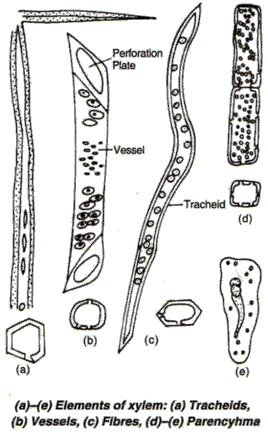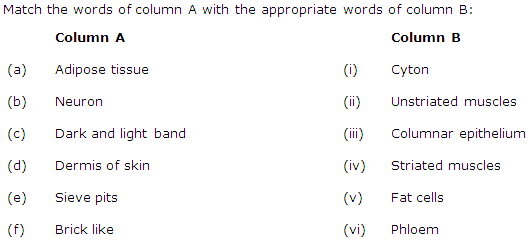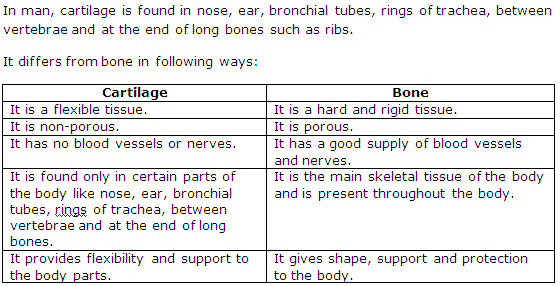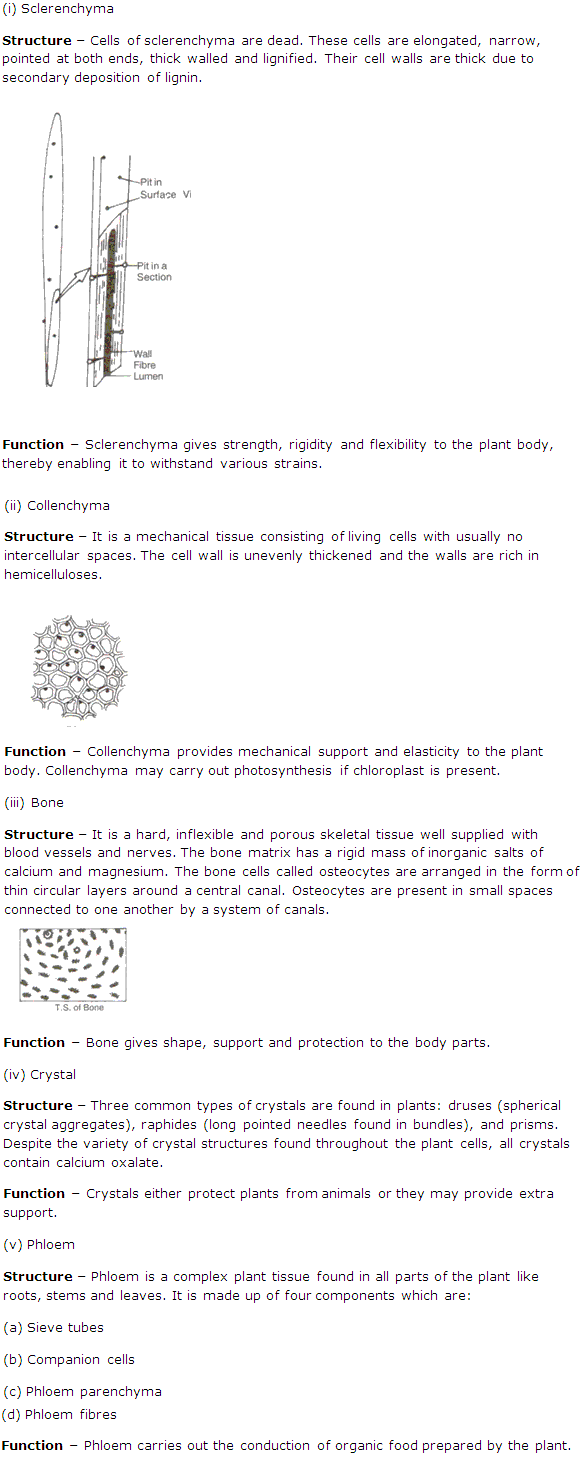Chapter 4 - Tissues Exercise 41
Question 1
What is a permanent tissue? It is of how many types?
Solution 1
Permanent tissue is a group of cells which temporarily or permanently cease to divide and thus assume permanent form and function.
Permanent tissues are of three types - simple tissues, complex tissues and special tissues.
Permanent tissues are of three types - simple tissues, complex tissues and special tissues.
Question 2
What is sclerenchyma? Explain its importance in plants.
Solution 2
Sclerenchyma is a type of simple tissue present commonly in roots, stems, leaves and petioles. Its cells are dead, elongated and narrow with thickened and lignified cell walls. Sclerenchyma is of two types i.e. fibres and sclerids.
Sclerenchyma gives strength, rigidity and flexibility to the plant body, thus enabling it to withstand various strains.
Sclerenchyma gives strength, rigidity and flexibility to the plant body, thus enabling it to withstand various strains.
Question 3
Explain type and function of xylem tissues.
Solution 3
Xylem is a complex plant tissue composed of several types of cells which are:
(i) Tracheids - These cells are long and tubular with thick, rigid and lignified walls and pointed ends. Tracheids are present in all vascular plants. These conduct water and minerals from root to stem.
(ii) Vessels - These are long cylindrical cells with lignified walls, placed one above the other to form a pipe like structure. They participate in the conduction of water and minerals.
(iii) Xylem fibres - These are sclerenchymatous fibres found attached to xylem. These provide strength to the plant organs.
(iv) Xylem parenchyma - This is the living component of xylem. Xylem parenchyma is composed of simple parenchyma cells found in xylem. These are connected with tracheids or vessels through simple or bordered pits. Their function is to store food material.

(i) Tracheids - These cells are long and tubular with thick, rigid and lignified walls and pointed ends. Tracheids are present in all vascular plants. These conduct water and minerals from root to stem.
(ii) Vessels - These are long cylindrical cells with lignified walls, placed one above the other to form a pipe like structure. They participate in the conduction of water and minerals.
(iii) Xylem fibres - These are sclerenchymatous fibres found attached to xylem. These provide strength to the plant organs.
(iv) Xylem parenchyma - This is the living component of xylem. Xylem parenchyma is composed of simple parenchyma cells found in xylem. These are connected with tracheids or vessels through simple or bordered pits. Their function is to store food material.

Question 4
What is a phloem? Name the components of it.
Solution 4
Phloem is a complex plant tissue found in all parts of the plant like roots, stems and leaves and is mainly responsible for the conduction of organic food prepared by the plant.
Phloem is made up of four components which are:
(i) Sieve tubes
(ii) Companion cells
(iii) Phloem parenchyma
(iv) Phloem fibres
Phloem is made up of four components which are:
(i) Sieve tubes
(ii) Companion cells
(iii) Phloem parenchyma
(iv) Phloem fibres
Chapter 4 - Tissues Exercise 42
Question 1
Why is blood called a tissue? Give reasons.
Solution 1
Blood is called a tissue since it contains many blood cells i.e. RBCs, WBCs and platelets working together to perform a common function. Blood connects the body systems together bringing the needed oxygen, nutrients, hormones and other signaling molecules, and removing the wastes.
Question 2
Give structure, types and functions in brief of any two of the following:
(i) Epithelial tissue
(ii) Muscular tissue
(iii) Connective tissue
(iv) Nervous tissue
(i) Epithelial tissue
(ii) Muscular tissue
(iii) Connective tissue
(iv) Nervous tissue
Solution 2
(i) Epithelial tissue:
Structure: The cells of epithelium are compactly placed, tightly held together and form a continuous sheet. Epithelial cells are supported below on a basement membrane. These cells may be of different shapes and sizes.
Types:
There are two main types of epithelial tissues which are:
(a) Simple and
(b) Compound
Functions:
(i) It forms a protective layer over the body and protects the underlying cells from drying up, injury, germs and harmful chemicals.
(ii) It absorbs water and other nutrients inside the body.
(iii) Some of these cells secrete ear wax, mucus, milk and digestive juices.
(ii) Muscular tissue:
Structure - Muscle tissue consists of cells which are elongated and large-sized, hence they are also called muscle fibres. These fibres are of various sizes. Contractile proteins are present in the muscle cells which bring about their contraction and relaxation. The cytoplasm of muscle fibre is called sarcoplasm and is bounded by a membrane called sarcolemma.
Types: Muscle tissue is of three types:
(i) Striated muscle tissue
(ii) Unstriated muscle tissue
(iii) Cardiac muscle tissue
Functions -
(i) Muscles bring about all voluntary movements done by a person.
(ii) All the involuntary movements needed to keep the body alive are possible due to muscles.
(iii) Connective tissue
Structure - This tissue has homogenous matrix which forms its main bulk. The connective tissue cells are living, separated from each other and are few in number. The matrix varies in size and shape and may be solid, gel like or liquid. The nature of the matrix decides the function of the connective tissue.
Types -
The following are the different types of connective tissue:
(a) Loose areolar connective tissue
(b) Fibrous connective tissue
(c) Cartilage connective tissue
(d) Bone
(e) Fluid connective tissue
Functions -
(i) Connective tissue connects and binds various organs of our body.
(ii) It gives support to the body and forms the skeleton to provide a definite shape.
(iii) It transports nutrients, hormones, oxygen and waste material within the body.
(iv) Nervous tissue:
Structure - The cells of nervous tissue is called neuron. It is capable of transmitting signals or impulses within the body. Each neuron consists of a cell body or cyton with a nucleus and elongated hair like extensions called axons and dendrites. Axons bundle together to form the nerve.
Functions - Nervous tissue is found in brain, spinal cord and nerves. It carries out transmission of signals or impulses within the body.
Structure: The cells of epithelium are compactly placed, tightly held together and form a continuous sheet. Epithelial cells are supported below on a basement membrane. These cells may be of different shapes and sizes.
Types:
There are two main types of epithelial tissues which are:
(a) Simple and
(b) Compound
Functions:
(i) It forms a protective layer over the body and protects the underlying cells from drying up, injury, germs and harmful chemicals.
(ii) It absorbs water and other nutrients inside the body.
(iii) Some of these cells secrete ear wax, mucus, milk and digestive juices.
(ii) Muscular tissue:
Structure - Muscle tissue consists of cells which are elongated and large-sized, hence they are also called muscle fibres. These fibres are of various sizes. Contractile proteins are present in the muscle cells which bring about their contraction and relaxation. The cytoplasm of muscle fibre is called sarcoplasm and is bounded by a membrane called sarcolemma.
Types: Muscle tissue is of three types:
(i) Striated muscle tissue
(ii) Unstriated muscle tissue
(iii) Cardiac muscle tissue
Functions -
(i) Muscles bring about all voluntary movements done by a person.
(ii) All the involuntary movements needed to keep the body alive are possible due to muscles.
(iii) Connective tissue
Structure - This tissue has homogenous matrix which forms its main bulk. The connective tissue cells are living, separated from each other and are few in number. The matrix varies in size and shape and may be solid, gel like or liquid. The nature of the matrix decides the function of the connective tissue.
Types -
The following are the different types of connective tissue:
(a) Loose areolar connective tissue
(b) Fibrous connective tissue
(c) Cartilage connective tissue
(d) Bone
(e) Fluid connective tissue
Functions -
(i) Connective tissue connects and binds various organs of our body.
(ii) It gives support to the body and forms the skeleton to provide a definite shape.
(iii) It transports nutrients, hormones, oxygen and waste material within the body.
(iv) Nervous tissue:
Structure - The cells of nervous tissue is called neuron. It is capable of transmitting signals or impulses within the body. Each neuron consists of a cell body or cyton with a nucleus and elongated hair like extensions called axons and dendrites. Axons bundle together to form the nerve.
Functions - Nervous tissue is found in brain, spinal cord and nerves. It carries out transmission of signals or impulses within the body.
Question 3

Solution 3
(a) - (v)
(b) - (i)
(c) - (iv)
(d) - (ii)
(e) - (vi)
(f) - (iii)
(b) - (i)
(c) - (iv)
(d) - (ii)
(e) - (vi)
(f) - (iii)
Question 4
Name the tissue associated with the following:
(i) Conduction of nerve impulse.
(ii) Rhythmic movement of the heart beat.
(iii) A man becoming fat.
(iv) Conduction of water in the plant body.
(v) Movement of food in the plant body
(i) Conduction of nerve impulse.
(ii) Rhythmic movement of the heart beat.
(iii) A man becoming fat.
(iv) Conduction of water in the plant body.
(v) Movement of food in the plant body
Solution 4
(i) Nervous tissue
(ii) Cardiac muscle tissue
(iii) Adipose tissue
(iv) Xylem
(v) Phloem
(ii) Cardiac muscle tissue
(iii) Adipose tissue
(iv) Xylem
(v) Phloem
Question 5
Name three kinds of muscles found in the human body giving one example of each.
Solution 5
The three kinds of muscles found in human body are:
(i) Striated muscle - An example is leg muscle
(ii) Unstriated muscle - An example is muscles in walls of uterus
(iii) Cardiac muscle - An example is heart muscle
(i) Striated muscle - An example is leg muscle
(ii) Unstriated muscle - An example is muscles in walls of uterus
(iii) Cardiac muscle - An example is heart muscle
Question 6
Write one word for the following:
(i) A group of similar cells which perform specific functions.
(ii) An organism whose body is made up of a single cell.
(iii) A group of tissues forming a new structure.
(i) A group of similar cells which perform specific functions.
(ii) An organism whose body is made up of a single cell.
(iii) A group of tissues forming a new structure.
Solution 6
(i) Tissue
(ii) Unicellular organism
(iii) Organ
(ii) Unicellular organism
(iii) Organ
Question 7
Name the tissues found
(i) at the outer layer of skin.
(ii) at the tip of a growing stem.
(iii) at the joints of two bones.
(iv) at the inner lining of the trachea.
(vi) in the testes and ovaries.
(i) at the outer layer of skin.
(ii) at the tip of a growing stem.
(iii) at the joints of two bones.
(iv) at the inner lining of the trachea.
(vi) in the testes and ovaries.
Solution 7
(i) Stratified epithelial tissue
(ii) Apical meristem
(iii) Ligament
(iv) Ciliated epithelium
(v) Cuboidal epithelium
(ii) Apical meristem
(iii) Ligament
(iv) Ciliated epithelium
(v) Cuboidal epithelium
Question 8
Give an outline classification of a plant or an animal tissue.
Solution 8

Question 9
Where is cartilage found in man? How does it differ from bone?
Solution 9

Question 10
Write 'True or False' for the following statements:
(i) Sclerenchyma cells have intercellular spaces.
(ii) The end of bones are connected with ligaments.
(iii) A vascular bundle conducts prepared food only.
(iv) A tracheid is longer than a vessel.
(v) Unicellular glands are called as globet cells.
(vi) Fibroblast cells are phagocytic in nature.
(i) Sclerenchyma cells have intercellular spaces.
(ii) The end of bones are connected with ligaments.
(iii) A vascular bundle conducts prepared food only.
(iv) A tracheid is longer than a vessel.
(v) Unicellular glands are called as globet cells.
(vi) Fibroblast cells are phagocytic in nature.
Solution 10
(i) False
(ii) True
(iii) False
(iv) True
(v) True
(vi) True
(ii) True
(iii) False
(iv) True
(v) True
(vi) True
Question 11
Every question has four answers. Choose the correct answer:
(i) Hard lignified thick walled, long and pointed cells in a plant are
(a) parenchyma
(b) sclerenchyma
(c) collenchyma
(d) sclereids
(ii) A group of cells alike in form, function and origin is called
(a) organ
(b) organelles
(c) tissue
(d) none of the above
(iii) A component of xylem is
(a) sieve tube
(b) sclereid
(c) medullary ray
(d) tracheid
(iv) The parenchymatous tissue is
(a) dead
(b) thin walled and living
(c) thick-walled
(d) made up of cellulose
(v) Collenchymatous hypodermis is found in
(a) monocot roots
(b) dicot roots
(c) monocot stems
(d) dicot stems
(vi) Phloem parenchyma, sclerenchyma, sieve tubes and companion cells are found in
(a) xylem
(b) phloem
(c) cambium
(d) cortex
(vii) Lymph can be defined as
(a) blood devoid of RBCs
(b) blood devoid of WBCs
(c) blood devoid of corpuscles
(d) none of the above
(viii) Connective tissue connects
(a) one bone to another
(b) two muscles
(c) a bone to nerve
(d) a muscle to nerve
(ix) Cardiac muscles are
(a) striated and voluntary
(b) with ten mitochondria
(c) non-striated
(d) striated and involuntary
(x) Blood is which type of tissue
(a) vascular connective tissue
(b) skeletal tissue
(c) alveolar connective tissue
(d) endodermal tissue
(i) Hard lignified thick walled, long and pointed cells in a plant are
(a) parenchyma
(b) sclerenchyma
(c) collenchyma
(d) sclereids
(ii) A group of cells alike in form, function and origin is called
(a) organ
(b) organelles
(c) tissue
(d) none of the above
(iii) A component of xylem is
(a) sieve tube
(b) sclereid
(c) medullary ray
(d) tracheid
(iv) The parenchymatous tissue is
(a) dead
(b) thin walled and living
(c) thick-walled
(d) made up of cellulose
(v) Collenchymatous hypodermis is found in
(a) monocot roots
(b) dicot roots
(c) monocot stems
(d) dicot stems
(vi) Phloem parenchyma, sclerenchyma, sieve tubes and companion cells are found in
(a) xylem
(b) phloem
(c) cambium
(d) cortex
(vii) Lymph can be defined as
(a) blood devoid of RBCs
(b) blood devoid of WBCs
(c) blood devoid of corpuscles
(d) none of the above
(viii) Connective tissue connects
(a) one bone to another
(b) two muscles
(c) a bone to nerve
(d) a muscle to nerve
(ix) Cardiac muscles are
(a) striated and voluntary
(b) with ten mitochondria
(c) non-striated
(d) striated and involuntary
(x) Blood is which type of tissue
(a) vascular connective tissue
(b) skeletal tissue
(c) alveolar connective tissue
(d) endodermal tissue
Solution 11
(i) (b) sclerenchyma
(ii) (c) tissue
(iii) (d) tracheid
(iv) (b) thin walled and living
(v) (d) dicot stems
(vi) (b) phloem
(vii) (a) blood devoid of RBCs
(viii) (a) one bone to another
(ix) (d) striated and involuntary
(x) (a) vascular connective tissue
(ii) (c) tissue
(iii) (d) tracheid
(iv) (b) thin walled and living
(v) (d) dicot stems
(vi) (b) phloem
(vii) (a) blood devoid of RBCs
(viii) (a) one bone to another
(ix) (d) striated and involuntary
(x) (a) vascular connective tissue
Question 12
Define the following:
(i) Tissue
(ii) Vascular tissue
(ii) Meristematic tissue
(iv) Permanent tissue
(i) Tissue
(ii) Vascular tissue
(ii) Meristematic tissue
(iv) Permanent tissue
Solution 12
(i) Tissue is a group of cells of similar structure and function.
(ii) Vascular tissue is the complex plant tissue in higher plants that is composed of xylem and phloem and is concerned with conducting water, minerals and organic food throughout the plant body.
(iii) Meristematic tissue is a group of cells which constantly divide and produce cells indefinitely throughout the life of the plant.
(iv) Permanent tissue refers to a group of cells which temporarily or permanently cease to divide and thus assume permanent form and function
(ii) Vascular tissue is the complex plant tissue in higher plants that is composed of xylem and phloem and is concerned with conducting water, minerals and organic food throughout the plant body.
(iii) Meristematic tissue is a group of cells which constantly divide and produce cells indefinitely throughout the life of the plant.
(iv) Permanent tissue refers to a group of cells which temporarily or permanently cease to divide and thus assume permanent form and function
Question 13
Differentiate between:
(i) Cell and Tissue
(ii) Parenchyma and collenchyma
(iii) Organ and organelle
(iv) Collenchyma and Sclerenchyma
(v) Nervous tissue and Nervous system
(vi) Blood and Lymph
(vii) Bone and Cartilage
(viii) Tendon and Ligament
(i) Cell and Tissue
(ii) Parenchyma and collenchyma
(iii) Organ and organelle
(iv) Collenchyma and Sclerenchyma
(v) Nervous tissue and Nervous system
(vi) Blood and Lymph
(vii) Bone and Cartilage
(viii) Tendon and Ligament
Solution 13

Question 14
Give structure and functions of the following:
(i) Sclerenchyma
(ii) Collenchyma
(iii) Bone
(iv) Crystal
(v) Phloem
(i) Sclerenchyma
(ii) Collenchyma
(iii) Bone
(iv) Crystal
(v) Phloem
Solution 14

Question 15
How many types of epithelial tissues have you studied? Write their functions.
Solution 15
There are two main types of epithelial tissues. These are:
(a) Simple and
(b) Compound
Simple epithelial tissue is further divided into six sub-groups which are:
(i) Columnar epithelium
(ii) Ciliated epithelium
(iii) Cuboidal epithelium
(iv) Squamous epithelium
(v) Glandular epithelium
(vi) Sensory epithelium
Compound epithelial tissue is of two types:
(i) Stratified epithelium
(ii) Transitional epithelium
Functions of epithelial tissue are:
(i) It forms a protective layer over the body and protects the underlying cells from drying up, injury, germs and harmful chemicals.
(ii) It absorbs water and other nutrients inside the body.
(iii) Some of these cells secrete ear wax, mucus, milk and digestive juices.
(a) Simple and
(b) Compound
Simple epithelial tissue is further divided into six sub-groups which are:
(i) Columnar epithelium
(ii) Ciliated epithelium
(iii) Cuboidal epithelium
(iv) Squamous epithelium
(v) Glandular epithelium
(vi) Sensory epithelium
Compound epithelial tissue is of two types:
(i) Stratified epithelium
(ii) Transitional epithelium
Functions of epithelial tissue are:
(i) It forms a protective layer over the body and protects the underlying cells from drying up, injury, germs and harmful chemicals.
(ii) It absorbs water and other nutrients inside the body.
(iii) Some of these cells secrete ear wax, mucus, milk and digestive juices.
Question 16
What is a nerve cell? Explain the importance of nervous tissue.
Solution 16
Nerve cell or neuron is a cell of the nervous system, capable of transmitting signals or impulses within the body. Each neuron consists of a cell body or cyton with a nucleus and elongated hair like extensions called axons and dendrites.
Nervous tissue is found in brain, spinal cord and nerves and carries out transmission of signals or impulses within the body.
Nervous tissue is found in brain, spinal cord and nerves and carries out transmission of signals or impulses within the body.

0 comments:
Post a Comment